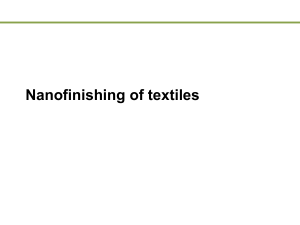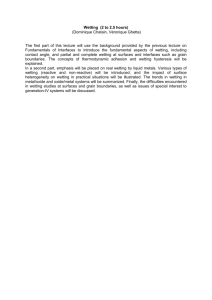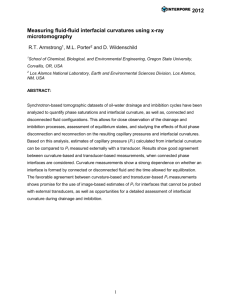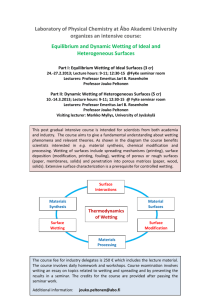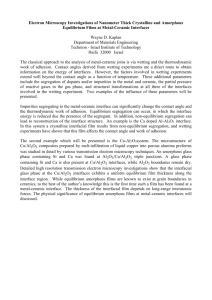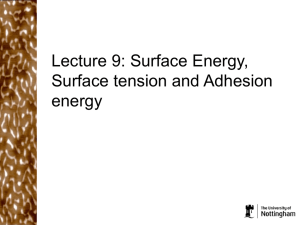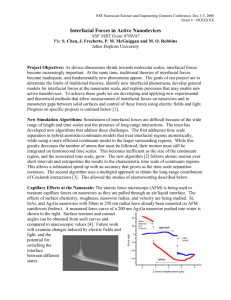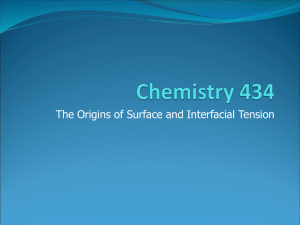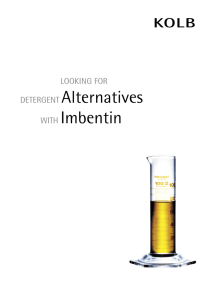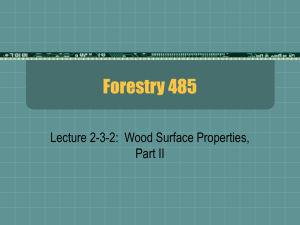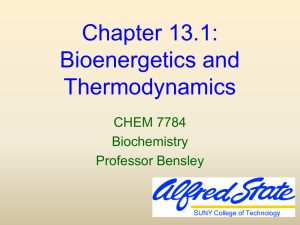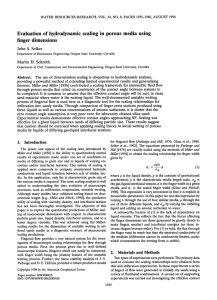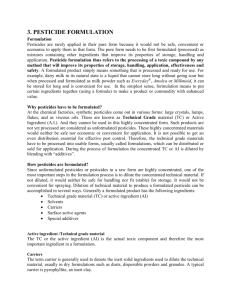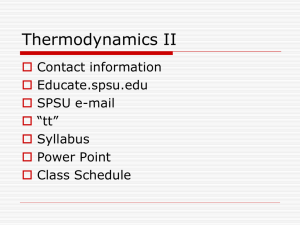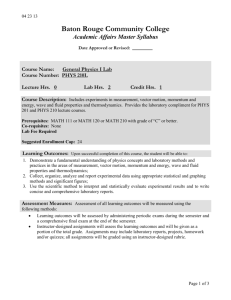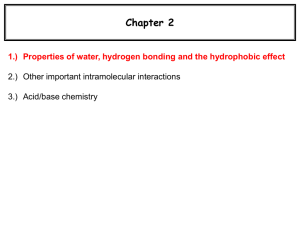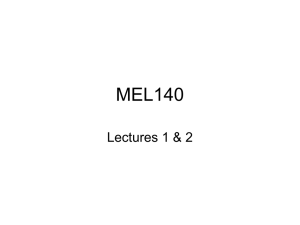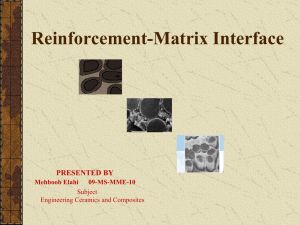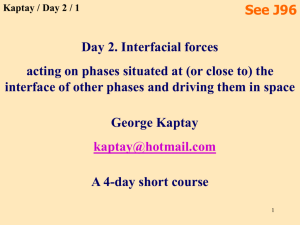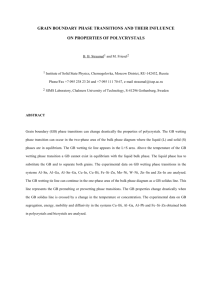Syllabus – MatSE 597 Wetting Properties of Materials: Theory and
advertisement
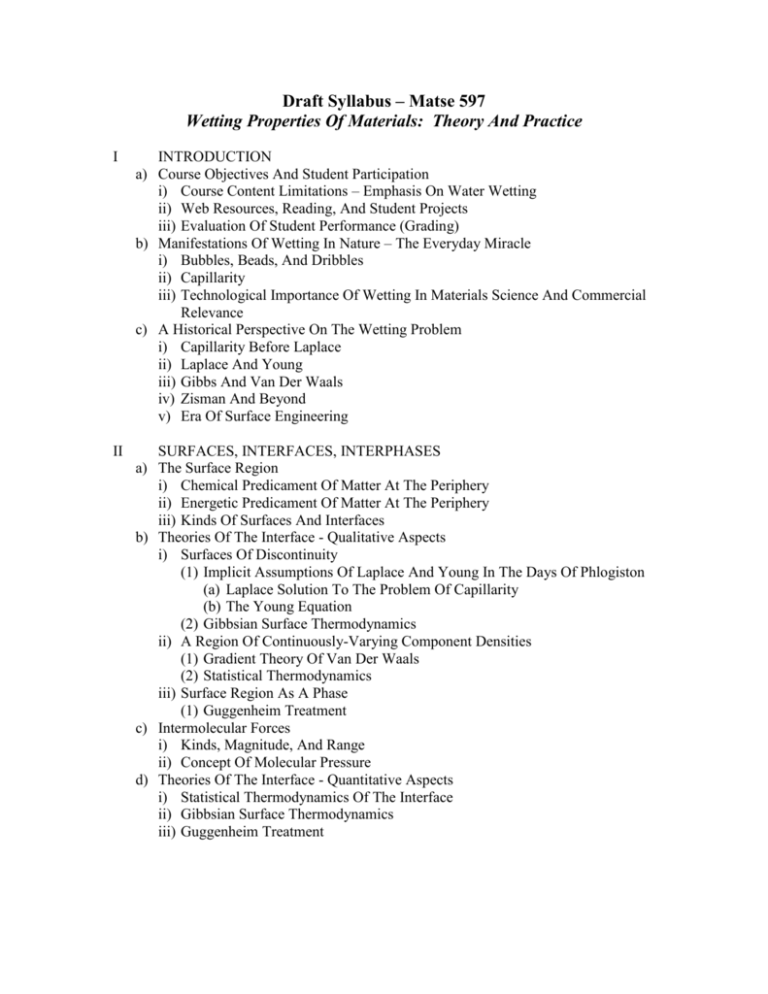
Draft Syllabus – Matse 597 Wetting Properties Of Materials: Theory And Practice I INTRODUCTION a) Course Objectives And Student Participation i) Course Content Limitations – Emphasis On Water Wetting ii) Web Resources, Reading, And Student Projects iii) Evaluation Of Student Performance (Grading) b) Manifestations Of Wetting In Nature – The Everyday Miracle i) Bubbles, Beads, And Dribbles ii) Capillarity iii) Technological Importance Of Wetting In Materials Science And Commercial Relevance c) A Historical Perspective On The Wetting Problem i) Capillarity Before Laplace ii) Laplace And Young iii) Gibbs And Van Der Waals iv) Zisman And Beyond v) Era Of Surface Engineering II a) b) c) d) SURFACES, INTERFACES, INTERPHASES The Surface Region i) Chemical Predicament Of Matter At The Periphery ii) Energetic Predicament Of Matter At The Periphery iii) Kinds Of Surfaces And Interfaces Theories Of The Interface - Qualitative Aspects i) Surfaces Of Discontinuity (1) Implicit Assumptions Of Laplace And Young In The Days Of Phlogiston (a) Laplace Solution To The Problem Of Capillarity (b) The Young Equation (2) Gibbsian Surface Thermodynamics ii) A Region Of Continuously-Varying Component Densities (1) Gradient Theory Of Van Der Waals (2) Statistical Thermodynamics iii) Surface Region As A Phase (1) Guggenheim Treatment Intermolecular Forces i) Kinds, Magnitude, And Range ii) Concept Of Molecular Pressure Theories Of The Interface - Quantitative Aspects i) Statistical Thermodynamics Of The Interface ii) Gibbsian Surface Thermodynamics iii) Guggenheim Treatment Erwin Vogler – MatSE 597c Page 2 III TENSIOMETRY – MEASUREMENT OF CONTACT ANGLES a) Liquid-Liquid And Liquid-Vapor Interface i) Wilhelmy Balance ii) Dunouy Ring iii) Pendant Drop iv) Drop Volume b) Solid-Liquid Interface i) The Phenomenon Of Contact Angle Hysteresis ii) Goniometry iii) Wilhelmy Balance c) Real Data i) Lab Tour And Hands-On Measurements ii) Calculations And Interpretations IV THEORY OF CONTACT ANGLES AND WETTABILITY a) Phenomenological Approaches i) Zisman Critical Surface Tension b) Interfacial Tension Component Theory (1) Propagation Of Intermolecular Forces Across The Interface (2) The Additivity Rule Of Interfacial Tension Components (a) Fowkes Theory (b) Combining Rules For Dispersion Forces (i) Arithmetic Mean (ii) Geometric Mean (iii)Harmonic Mean (c) Combining Rules For Acid-Base Interactions (i) Lewis Acid-Base Interactions (ii) Monopolar Components 1. Theory Of Good, Van Oss, Chaudhury (Gvoc) c) Equation Of State Theory i) Neumann Theory V WATER CHEMISTRY AND THE HYDROPHOBIC EFFECT a) Self Association In Water i) Historical Perspective ii) Hydrogen Bonding iii) Generalized Lewis Acid-Base iv) Self Associated Network b) Vicinal Water – The Idea That Won’t Go Away i) Historical Perspective ii) Experimental And Theoretical Evidence Or Lack Thereof iii) Speculation On Vicinal Water Solvent Properties iv) Relationship to Theories Of Water Wetting c) The Hydrophobic Effect i) Thermodynamics (1) Entropic And Enthalpic Effects 2/6/2016 Erwin Vogler – MatSE 597c Page 3 (2) Temperature Sensitivity ii) Hydrophobic Hydration And Self Assembly iii) Biological And Environmental Impact Of The Hydrophobic Effect VI AMPHILICITY AND SURFACTANCY a) Physical Chemistry Of Adsorption i) Physisorption ii) Chemisorption b) Amphilicity – A Solution-Phase Ambiguity i) Molecular Structure And The Hydrophobic Effect ii) Surfactants And Detergents (1) Classes Of Synthetic Surfactants (2) Biosurfactants c) Adsorption To Liquid-Vapor Interfaces i) Interfacial Energetics ii) Concentration-Dependent Interfacial Tension (1) Tensiometry (2) Surface Thermodynamic Interpretation iii) Kinetics iv) Real Data (1) Lab Tour And Hands-On Measurements (2) Calculations And Interpretations d) Adsorption To Solid-Liquid Interfaces i) Interfacial Energetics ii) Concentration-Dependent Interfacial Tension (1) Tensiometry (2) Surface Thermodynamic Interpretation iii) Kinetics iv) Real Data (1) Lab Tour And Hands-On Measurements (2) Calculations And Interpretations 2/6/2016
